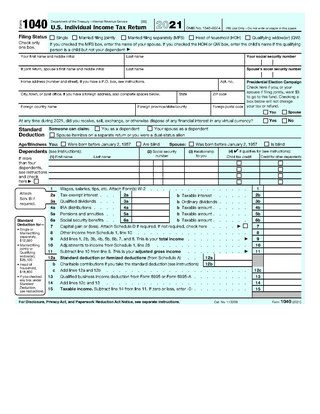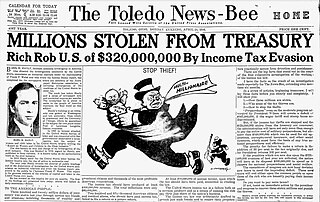Related Research Articles

Form 1040, officially, the U.S. Individual Income Tax Return, is an IRS tax form used for personal federal income tax returns filed by United States residents. The form calculates the total taxable income of the taxpayer and determines how much is to be paid to or refunded by the government.

The United States of America has separate federal, state, and local governments with taxes imposed at each of these levels. Taxes are levied on income, payroll, property, sales, capital gains, dividends, imports, estates and gifts, as well as various fees. In 2020, taxes collected by federal, state, and local governments amounted to 25.5% of GDP, below the OECD average of 33.5% of GDP.
Garnishment is a legal process for collecting a monetary judgment on behalf of a plaintiff from a defendant. Garnishment allows the plaintiff to take the money or property of the debtor from the person or institution that holds that property. A similar legal mechanism called execution allows the seizure of money or property held directly by the debtor.

Intuit Inc. is an American business software company that specializes in financial software. The company is headquartered in Mountain View, California, and the CEO is Sasan Goodarzi. Intuit's products include the tax preparation application TurboTax, personal finance app Mint, the small business accounting program QuickBooks, the credit monitoring service Credit Karma, and email marketing platform Mailchimp. As of 2019, more than 95% of its revenues and earnings come from its activities within the United States.
Three key types of withholding tax are imposed at various levels in the United States:
A tax refund or tax rebate is a payment to the taxpayer due to the taxpayer having paid more tax than they owed.
The Employer Identification Number (EIN), also known as the Federal Employer Identification Number (FEIN) or the Federal Tax Identification Number, is a unique nine-digit number assigned by the Internal Revenue Service (IRS) to business entities operating in the United States for the purposes of identification. When the number is used for identification rather than employment tax reporting, it is usually referred to as a Taxpayer Identification Number (TIN). When used for the purposes of reporting employment taxes, it is usually referred to as an EIN. These numbers are used for tax administration and must not be used for any other purpose. For example, an EIN should not be used in tax lien auction or sales, lotteries, or for any other purposes not related to tax administration.
Tax withholding, also known as tax retention, Pay-As-You-Go/Pay-As-You-Earn, tax deduction at source or a Prélèvement à la source, is income tax paid to the government by the payer of the income rather than by the recipient of the income. The tax is thus withheld or deducted from the income due to the recipient. In most jurisdictions, tax withholding applies to employment income. Many jurisdictions also require withholding taxes on payments of interest or dividends. In most jurisdictions, there are additional tax withholding obligations if the recipient of the income is resident in a different jurisdiction, and in those circumstances withholding tax sometimes applies to royalties, rent or even the sale of real estate. Governments use tax withholding as a means to combat tax evasion, and sometimes impose additional tax withholding requirements if the recipient has been delinquent in filing tax returns, or in industries where tax evasion is perceived to be common.

The United States federal government and most state governments impose an income tax. They are determined by applying a tax rate, which may increase as income increases, to taxable income, which is the total income less allowable deductions. Income is broadly defined. Individuals and corporations are directly taxable, and estates and trusts may be taxable on undistributed income. Partnerships are not taxed, but their partners are taxed on their shares of partnership income. Residents and citizens are taxed on worldwide income, while nonresidents are taxed only on income within the jurisdiction. Several types of credits reduce tax, and some types of credits may exceed tax before credits. An Alternative Minimum Tax (AMT) applies at the federal and some state levels.
A payment is the tender of something of value, such as money or its equivalent, by one party to another in exchange for goods or services provided by them, or to fulfill a legal obligation or philanthropy desire. The party making the payment is commonly called the payer, while the payee is the party receiving the payment. Whilst payments are often made voluntarily, some payments are compulsory, such as payment of a fine.
The United States Internal Revenue Service uses forms for taxpayers and tax-exempt organizations to report financial information, such as to report income, calculate taxes to be paid to the federal government, and disclose other information as required by the Internal Revenue Code (IRC). There are over 800 various forms and schedules. Other tax forms in the United States are filed with state and local governments.
E-file is a system for submitting tax documents to the US Internal Revenue Service through the Internet or direct connection, usually without the need to submit any paper documents. Tax preparation software with e-filing capabilities includes stand-alone programs or websites. Tax professionals use tax preparation software from major software vendors for commercial use.

The Internal Revenue Service (IRS) is the revenue service for the United States federal government, which is responsible for collecting U.S. federal taxes and administering the Internal Revenue Code, the main body of the federal statutory tax law. It is an agency of the Department of the Treasury and led by the Commissioner of Internal Revenue, who is appointed to a five-year term by the President of the United States. The duties of the IRS include providing tax assistance to taxpayers; pursuing and resolving instances of erroneous or fraudulent tax filings; and overseeing various benefits programs, including the Affordable Care Act.
The Preparer Tax Identification Number (PTIN) is an identification number that all paid tax return preparers must use on U.S. federal tax returns or claims for refund submitted to the Internal Revenue Service (IRS). Anyone who, for compensation, prepares all or substantially all of any federal tax return or claim for refund must obtain a PTIN issued by the IRS.
Dwolla is a United States-only fintech company that provides businesses with a connection to the ACH Network or RTP Network.

The Foreign Account Tax Compliance Act (FATCA) is a 2010 U.S. federal law requiring all non-U.S. foreign financial institutions (FFIs) to search their records for customers with indicia of a connection to the U.S., including indications in records of birth or prior residency in the U.S., or the like, and to report such assets and identities of such persons to the United States Department of the Treasury. FATCA also requires such persons to report their non-U.S. financial assets annually to the Internal Revenue Service (IRS) on form 8938, which is in addition to the older and further redundant requirement to report them annually to the Financial Crimes Enforcement Network (FinCEN) on form 114. Like U.S. income tax law, FATCA applies to U.S. residents and also to U.S. citizens and green card holders residing in other countries.

Under the federal law of the United States of America, tax evasion or tax fraud, is the purposeful illegal attempt of a taxpayer to evade assessment or payment of a tax imposed by Federal law. Conviction of tax evasion may result in fines and imprisonment. Compared to other countries, Americans are more likely to pay their taxes on time and law-abidingly.
The Federal Data Services Hub is a tool used to facilitate the government-backed Patient Protection and Affordable Care Act health coverage program.
United States virtual currency law is financial regulation as applied to transactions in virtual currency in the U.S. The Commodity Futures Trading Commission has regulated and may continue to regulate virtual currencies as commodities. The Securities and Exchange Commission also requires registration of any virtual currency traded in the U.S. if it is classified as a security and of any trading platform that meets its definition of an exchange.
In the United States, Form 1099-MISC is a variant of Form 1099 used to report miscellaneous income. One notable use of Form 1099-MISC was to report amounts paid by a business to a non-corporate US resident independent contractor for services, but starting tax year 2020, this use was moved to the separate Form 1099-NEC. The ubiquity of the form has also led to use of the phrase "1099 workers" or "the 1099 economy" to refer to the independent contractors themselves. Other uses of Form 1099-MISC include rental income, royalties, and Native American gaming profits.
References
- 1 2 "Welcome to EFTPS - Help & Information". Electronic Federal Tax Payment System. Retrieved April 14, 2014.
- 1 2 3 4 "Frequently asked questions about EFTPS". Bethpage Federal Credit Union . Retrieved April 14, 2014.
- ↑ "EFTPS: The Electronic Federal Tax Payment System". Internal Revenue Service . Retrieved April 14, 2014.
- ↑ "EFTPS: Overview". Financial Management Service . Retrieved April 14, 2014.
- 1 2 Ebeling, Ashlea (April 8, 2014). "The Easy Way To Make Estimated Tax Payments". Forbes . Retrieved April 14, 2014.
- ↑ "Electronic Federal Tax Payment System (EFTPS) Enrollment to e-pay 940 and 941/944". Intuit . Retrieved April 14, 2014.
- ↑ "Electronic Federal Tax Payment System - EFTPS". Investopedia . Retrieved April 14, 2014.
- ↑ "NCS contract to bring 100 new jobs here". Iowa City Press-Citizen (Iowa City, Iowa). October 10, 1994. p. 10A.
- 1 2 3 Coffee, Gertha (October 12, 1994). "NationsBank to help monitor U.S. tax revenue". The Atlanta Constitution. p. F3.
- ↑ "AAPEX Systems Inc.: Plan expansion to bigger office". Arizona Star-Gazette. January 30, 1994. p. 11AA.
- 1 2 3 "IRS updates technology to speed filings". Knight-Ridder Newspapers. Daily Press (Newport News, Virginia). June 28, 1996. p. C6.
- ↑ "Electronic tax payments". Asbury Park Press (Asbury Park, New Jersey). July 22, 1996. p. C1.
- ↑ Vanac, Mary (October 7, 1996). "Firms grid for electronic payroll-tax transfer". Night-Ridder Newspapers. Albuquerque Journal (Albuquerque, New Mexico). p. 24.
- 1 2 3 "Frequently Asked Questions". Electronic Federal Tax Payment System. Retrieved April 14, 2014.